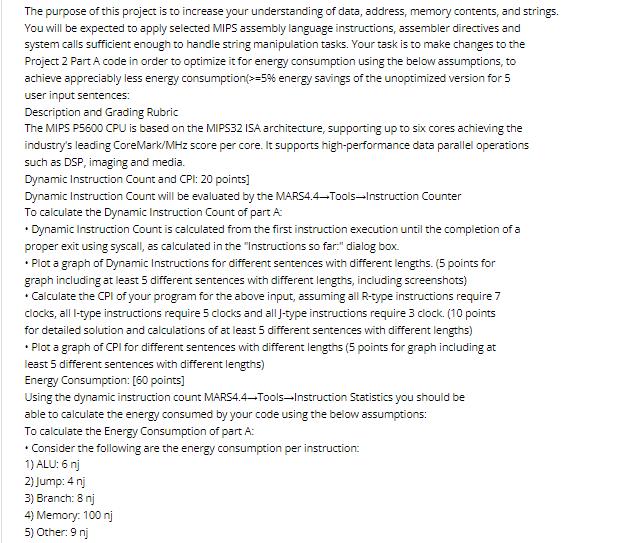Answered step by step
Verified Expert Solution
Question
1 Approved Answer
The purpose of this project is to increase your understanding of data, address, memory contents, and strings. You will be expected to apply selected


The purpose of this project is to increase your understanding of data, address, memory contents, and strings. You will be expected to apply selected MIPS assembly language instructions, assembler directives and system calls sufficient enough to handle string manipulation tasks. Your task is to make changes to the Project 2 Part A code in order to optimize it for energy consumption using the below assumptions, to achieve appreciably less energy consumption(>=5% energy savings of the unoptimized version for 5 user input sentences: Description and Grading Rubric The MIPS P5600 CPU is based on the MIPS32 ISA architecture, supporting up to six cores achieving the industry's leading CoreMark/MHz score per core. It supports high-performance data parallel operations such as DSP, imaging and media. Dynamic Instruction Count and CPI: 20 points] Dynamic Instruction Count will be evaluated by the MARS4.4-Tools-Instruction Counter To calculate the Dynamic Instruction Count of part A: Dynamic Instruction Count is calculated from the first instruction execution until the completion of a proper exit using syscall, as calculated in the "Instructions so far:" dialog box. Plot a graph of Dynamic Instructions for different sentences with different lengths. (5 points for graph including at least 5 different sentences with different lengths, including screenshots) Calculate the CPI of your program for the above input, assuming all R-type instructions require 7 clocks, all l-type instructions require 5 clocks and all J-type instructions require 3 clock. (10 points for detailed solution and calculations of at least 5 different sentences with different lengths) Plot a graph of CPI for different sentences with different lengths (5 points for graph including at least 5 different sentences with different lengths) Energy Consumption: [60 points] Using the dynamic instruction count MARS4.4-Tools-Instruction Statistics you should be able to calculate the energy consumed by your code using the below assumptions: To calculate the Energy Consumption of part A: Consider the following are the energy consumption per instruction: 1) ALU: 6 nj 2) Jump: 4 nj 3) Branch: 8 nj 4) Memory: 100 nj 5) Other: 9 nj Plot a graph of Energy consumption for different sentences with different lengths before optimization of the code. (10 points for detailed calculation+5 points for graph including at least 5 different sentences with different lengths, include screenshots) Optimize your code to consume appreciably less energy (minimum of 5% energy savings over the unoptimized version on an average for the input sentences chosen) based on the assumptions above. (15 points for code implementations achieving target energy reduction, 5 points for correct outputs and code output formatting, 5 points for code comments, 5 points for energy calculations and energy change percentages achieved over un-optimized code for the 5 different sentences) Explain in detail what was your strategy in terms of changes made in the MIPS code, instructions, algorithm etc. that you applied to reduce the energy consumption? And mention what was the reasoning behind choosing that strategy. (10 points for details and clarity of the explanation.) Plot a graph of Energy consumption for different sentences with different lengths after optimization of the code. (5 points for graph including at least 5 different sentences with different lengths) MIPS/mW: [10 points] Use the information of the two previous sections to determine MIPS/mW for the optimized code as illustrated in Module 8 (Device Technology)-Slide 30 (assume Clock Cycle is 400ps). (10 points for detailed solution and calculations of at least 5 different sentences with different lengths)
Step by Step Solution
There are 3 Steps involved in it
Step: 1

Get Instant Access to Expert-Tailored Solutions
See step-by-step solutions with expert insights and AI powered tools for academic success
Step: 2

Step: 3

Ace Your Homework with AI
Get the answers you need in no time with our AI-driven, step-by-step assistance
Get Started


